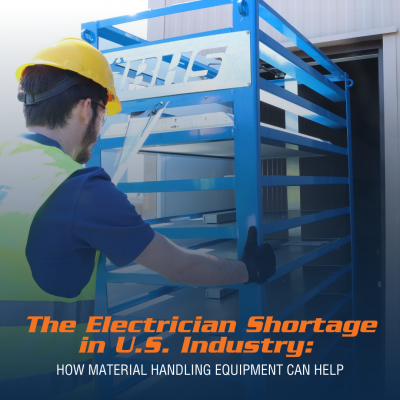We use cookies to make your experience better. To comply with the new e-Privacy directive, we need to ask for your consent to set the cookies. Learn more.
The Electrician Shortage in U.S. Industry: How Material Handling Equipment Can Help

How serious is the electrician shortage? According to the National Electrical Contractors Association, 10,000 electricians retire every year while a mere 7,000 join the workforce. Meanwhile, the Bureau of Labor Statistics estimates that employment in the field will grow by 10 percent from 2018 to 2028.
Labor costs are rising accordingly. The median salary for an electrician is currently around $55,000, but industrial electricians often earn significantly higher salaries. As demand for skilled electrical professionals continues to grow, salaries will likely climb — potentially into the six-figure range, per some estimates — and electrical contractors will need to find creative solutions for completing workplace tasks safely while keeping costs under control.
The takeaway is clear: To maintain consistent throughput and complete installations and repairs as efficiently as possible, contractors may need to limit the number of onsite electricians. That’s not always feasible, of course — some tasks need an electrician’s oversight, period — but the right equipment can allow a single worker to handle tasks that might otherwise require a whole team. As the old adage goes, “work smarter, not harder.”
Electrical distributors play a key role in maximizing their customers’ productivity. Here are a few ways distributors can help contractors succeed with smaller teams:
Offer equipment that limits ergonomic hazards wherever possible.
According to the U.S. Department of Labor, from 1999 to 2002, more than 30 percent of all employee compensation claims from independent electrical contractors were related to ergonomics. Of course, employers should always take the necessary steps to prevent injuries for the sake of their employees, but there’s another reason to invest in ergonomics: Better equipment allows individual workers to handle difficult tasks with ease, improving throughput and limiting necessary staff. That’s particularly important for transporting conduit, wire coils, and other electrical essentials.BHS offers a range of ergonomic products designed for electrical work. A whole line of Electrical Material Carts allow single workers to transport bulk components. For example, the Light Fixture Cart (LFC) hauls a full job’s worth of light fixtures through the work site; the Transformer Cart (TC) provides ergonomic handling for portable power units; and Tilting Elevator Conduit Carts (CC-ELV-1K) move conduit loads through narrow aisles and small elevator carriages. Evaluate your operation’s needs and make sure to utilize ergonomic equipment for any tasks that require lifting, twisting, turning, or positioning.
Ship electrical material orders as full delivered solutions.
It takes time to prepare electrical components for use at the jobsite. Distributors can help their customers by shipping orders packaged on pre-loaded, ready-to-use material handling equipment
For instance, rather than shipping cable orders on wooden reels, load them onto the multiple steel spools of a Parallel Reel Payout (PRP). This pull-ready unit provides workers with consistent access to optimally positioned spools and reels, each containing a different cable for easy on-site parallel pulls. Distributors can either include the PRP unit in the order or require customers to return them after use — either way, they’ve saved their customers time, effort, and, ultimately, money.
Make sure electrical contractors can access software and tools in the field.
Electrical workers need access to a range of specialized devices to handle onsite jobs. While they can move equipment to and from the jobsite every day, that’s not always practical (and it certainly isn’t efficient).
The BHS High Value Cart (HVC) and Bifold High Value Cart (HVC-BF) allow secure storage for PPE, tools, and any other items that electricians need to perform their work effectively. The carts can be moved easily, but their high-quality steel construction keeps high-value assets safe.
The High Value Cart - Work Station (HVC-WS) and Building Information Modeling Cart (BIM) provide similar functionality, but with built-in workstations that give workers a surface for handling certain tasks. The BIM is designed for on-site construction project administration and protects computer components in the field, allowing administrators to view digital building plans in virtually any environment. Providing this equipment to contractors streamlines their operations, helping to offset limited staffing.
When addressing any worker shortage, the first course of action is to look at efficiency — by improving productivity, contractors can often limit staff expenditures while building towards flexibility and scalability. Distributors can help by providing the tools contractors need to accomplish this task. BHS material handling equipment allows electricians and other electrical workers to keep throughput high through a combination of better ergonomics, IIoT features, and superior engineering.
